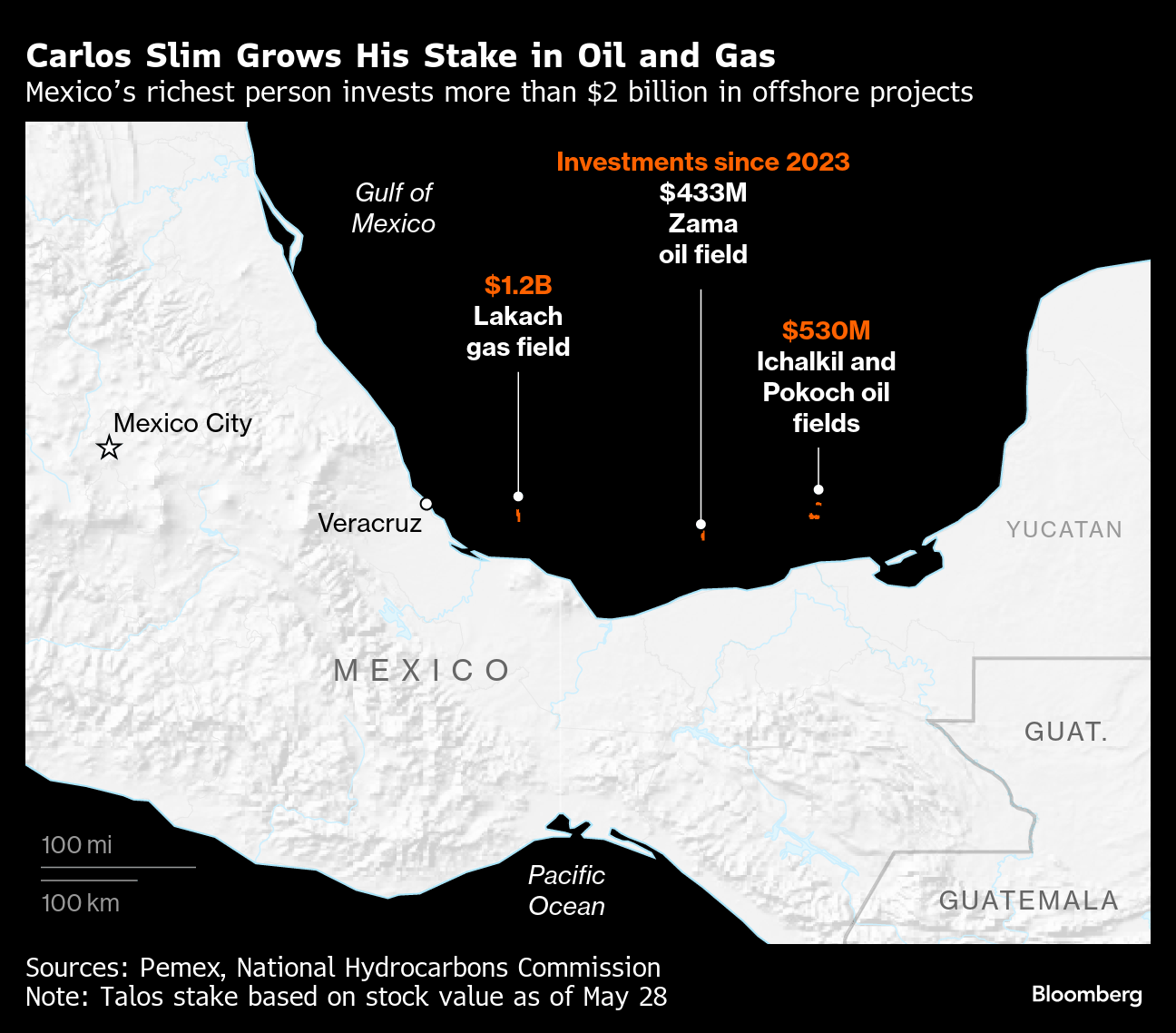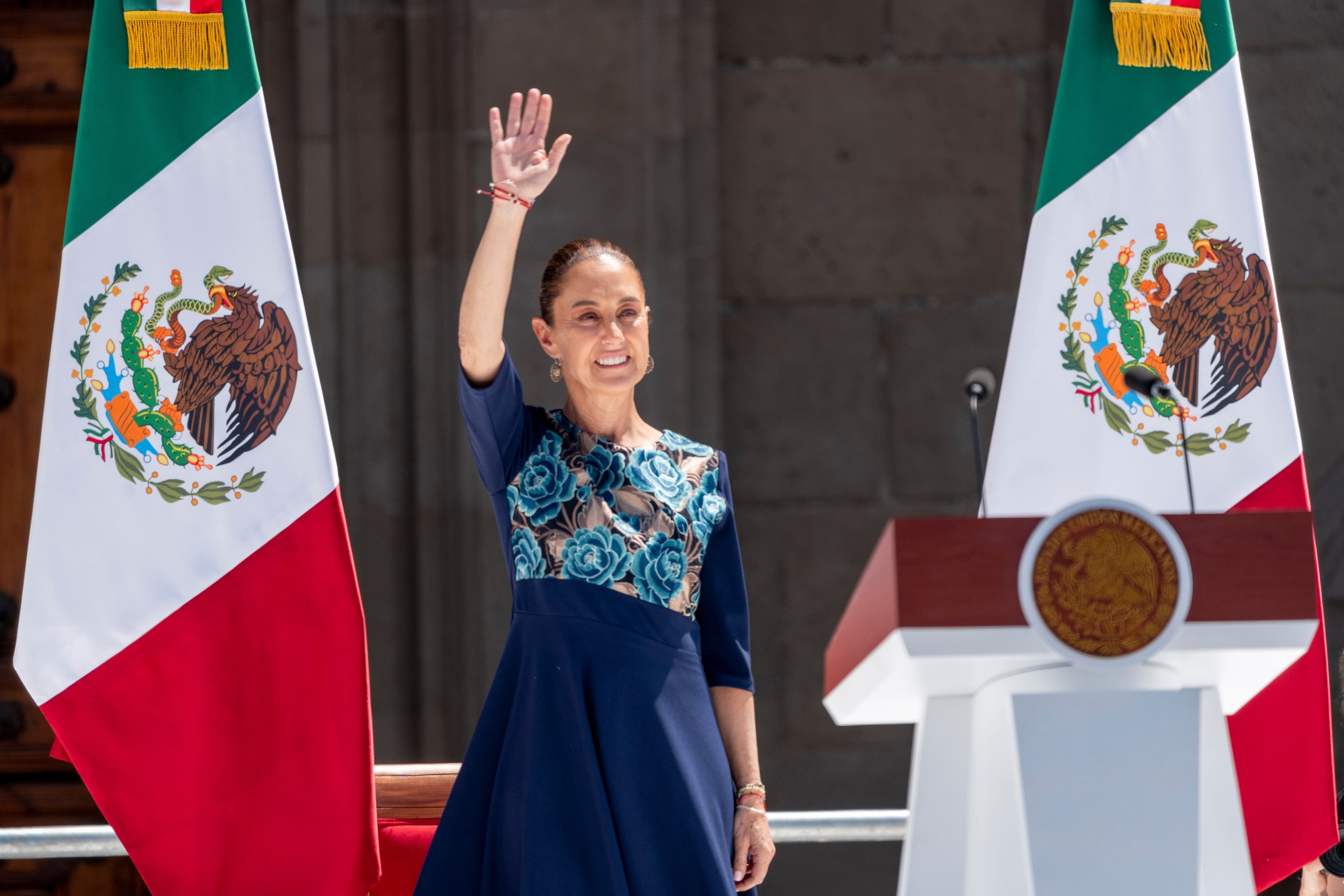Carlos Slim Is Quietly Becoming Pemex’s Partner of Last Resort
(Bloomberg) -- The transformation of Mexico’s richest person into its most important oil baron came about slowly, almost subtly. Carlos Slim built up a stake in Talos Energy Inc. before flipping it for the company’s Mexican unit. There was a 2023 deal for $530 million to buy a pair of oilfield assets from a fellow billionaire. Then a $1.2 billion plan to develop a gas deposit in the Gulf of Mexico.
Add it all up, and Slim has spent more than $2 billion to become the most prominent private partner to state-owned Petroleos Mexicanos — and, really, one of the only investors willing to do business with the heavily indebted, operationally challenged oil monopoly.
Slim built his $94 billion empire on the back of a dominant telecommunications company that was privatized, and there’s a sort of poetry to the idea of the 85-year-old in the twilight of his career following a similar path to the one that vaulted him into the stratosphere of global wealth. Just as in the 1990 government auction of Telmex, Slim has a president leaning on him for help, a money-losing company that needs a jolt of efficiency, and an industry with little competition.
“He’s a pure monopolist, and who doesn’t like a good monopoly?” said John Padilla, managing director of energy consultancy IPD Latin America. “He plays a very different game altogether than anyone else because he has so many pockets he can reach into.”
Through his firm Grupo Carso SAB, Slim has a minority stake in the Zama offshore field that’s expected to account for 10% of Mexico’s oil output and has partnered with Pemex in tapping the deep-water Lakach gas project. And while fossil-fuel exploitation is a relatively new operation for him, he’s inherited experienced executives and engineers through his acquisitions.
Yet the telecom magnate’s deep pockets may not be enough for Pemex to dig itself out from under a $100 billion debt pile and restore oil production that’s slumped to a 40-year low. The company’s financial woes are reaching a crisis point after four straight quarterly losses, and even with Slim’s support it could take years to exploit the Zama and Lakach deposits.
Slim’s spokesman and son-in-law declined to comment for this story. Pemex didn’t respond to a request for comment.

Investors have been fleeing Pemex, like Norway’s sovereign wealth fund, which excluded the state firm from its portfolio last month over corruption concerns. Other big players sold their Mexican assets or stopped investing after Andres Manuel Lopez Obrador’s administration ended oil auctions and farm-out deals with Pemex. Meanwhile, a slew of oil spills, fires and deadly accidents have made investors queasy in recent years, despite the government’s promises of continued financial support.
Partnering with Pemex “is a nightmare for anyone right now unless you have some sort of government guarantee that things are going to go well,” said Alejandro Schtulmann, president of Emerging Markets Political Risk Analysis, a Latin America-focused advisory firm. Yet Slim has “decided that if he is going to get into this business he’s going to do it properly and try to put together something big.”
So far Slim, who has cultivated good working relationships with whomever occupies Palacio Nacional, is impressed by Lopez Obrador’s successor, President Claudia Sheinbaum. They speak every few months and occasionally exchange text messages. “The president is good. She’s a hard worker,” Slim said in a February interview with Bloomberg. “She’s understood that she needs investment from the private sector.”
Sheinbaum’s energy reforms are an attempt to bring foreign capital back into Mexico by encouraging private players to partner in minority stake deals with the oil giant. But Padilla warned the new framework may not be enough to attract international companies into upstream projects and turn around production in Mexico’s maturing oil and gas fields. “You need incentives,” the IPD managing director said, and the new regulations “function as an unnecessary straitjacket.”
Mexico’s energy ministry didn’t respond to a request for comment, nor did Sheinbaum’s office.

Even before the latest reforms, Slim was at the forefront of private capital’s return to Mexico’s energy sector. He bankrolled Pemex’s Lakach effort when US liquefied natural gas company New Fortress Energy Inc. pulled out in 2023.
Slim also invested in Talos after it ran into regulatory issues under Lopez Obrador. The Houston driller was forced to relinquish operation and majority control of the 800-million-barrel Zama discovery in 2021 — a decision based on one independent study. The move sapped investor confidence and paved the way for Slim to acquire some 80% of the company’s Mexican unit, giving him a significant stake in Zama.
For Talos, Slim’s involvement offered a level of protection for the investment that had become more precarious under Mexico’s nationalist government, according to a person with direct knowledge of the situation who requested anonymity because the discussions were private. While the magnate stepping in didn’t result in a fast-tracked process, it did offer assurances the project wouldn’t languish in regulatory limbo, the person said.
Indeed, Slim’s 2023 acquisition of PetroBal SAPI, which gave him half the rights to two oil fields off the coast of Campeche, won praise from Lopez Obrador at the time. The president celebrated the deal “because it stays in the hands of Mexicans.” It also brought PetroBal’s top executive, who had presided over Pemex’s exploration and production arm from 2004 to 2014, onto Slim’s team.
Slim is looking to lower costs and boost output at the Campeche blocks. “We need to open up more wells and buy a new platform,” he said in February. “We’d likely build that platform ourselves within two years,” adding that he sees the venture producing 40,000 barrels of oil a day by next year, increasing to 80,000 barrels in the future, depending on how the market evolves.
Still, there are myriad technical challenges that come with offshore oil drilling. In the case of his Talos assets, Slim conceded he hasn’t “defined” how Zama will be developed. “It’s 180 meters below sea level, so building a platform would take a long time and represent an enormous cost,” he said. “But we’re studying that option, or some semi-submergible platforms.”
With production from that oil field and the Lakach gas project a long way off, Pemex is suffering. Crude and condensate production slumped this year to just 1.6 million barrels per day, down 11% from a year earlier. And its output is less than half what it was at its peak two decades ago.
Slim’s team is “making an interesting push, but it will entirely depend on their capacity to execute upstream projects where they lack experience,” said Pablo Medina, head of new ventures at oil consultancy Welligence. “Obviously they have the political capital to feel confident enough to try.”
©2025 Bloomberg L.P.





